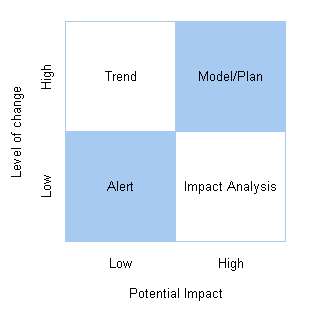Capacity Management is a vital and integral function to any successful IT organisation. In an ideal world all IT services would be capacity managed throughout their life-cycle. However in a medium to large organisation it is not possible to spend the required amount of time on each service that the business user would often like, although when offered the choice to pay for their desired level of capacity management they usually decline. This mismatch of demand for, and supply of, capacity management services is an intriguing issue for a capacity manager to deal with, for it is his de facto role; therefore the way he deals with this problem can, to the business user, be indicative of his skills as a Capacity Manager.
So the challenge is how to deliver capacity management service by pragmatically balancing demand and supply. The obvious solution (although not the only one) is to 'ration' the service. This can be decided along several different lines - by business unit for example. The most common approach is to prioritise which IT services are capacity managed and, if possible, to what level. This can be categorised, for example, as "Gold, Silver and Bronze", in line with the method used in many organisations to categorise services. This prioritisation should be decided by the business user, not the Capacity Manager.
The Capacity Manager must then determine how to match the resources at his disposal to this list of prioritised services, and what is achievable in their organisation. Determining what can be achieved is based on understanding the delivery capability of the processes, organisation and tools available; for instance how efficient is the capacity management process (how much resource to plan and manage each service) and how effective it is (the accuracy of proactive planning in reducing the need for reactive management). The Capacity Manager should have a good understanding of this - ideally it has been quantified previously for inclusion in calculating operational expense costs in business cases for new IT services.
Once this has been quantified the Capacity Manager can produce a resource model for his own department. This is a powerful tool as it enables him to quantify exactly how many services can be managed in each category, for instance: 5 Gold, 10 Silver and 20 Bronze. The remaining services are covered as "Best Endeavours" and allocated a small amount of time (perhaps 1-5 days per year). This gives a total man-day budget figure which, taking holidays, management overhead (e.g. unbudgeted meetings etc) and sickness into account, gives a figure for total resources required. If this is in excess of the resources available to the Capacity Manager then this needs to be rationalised and aligned to the budget.
Another method of prioritising the Capacity Management resources is a risk-based analysis. Each service should be reviewed to determine the likelihood of a capacity-related problem with the service, usually based on the amount of change occurring on that service or platform, and then its impact if such a problem arises. This risk/impact analysis can then be used to determine the best method for delivering Capacity Management to each IT service. The table below demonstrates one possible solution:
All these solutions require that Capacity Management has a well-documented, defined and tested set of 'products', the minimum set of which is:
- 'Trended Capacity Planning': The use of automated trending reports to identify potential capacity shortfalls in the near future
- 'Capacity Alerting': The definition of thresholds in an capacity monitoring system to automatically alert when they are breached
- 'Impact Analysis': The manual analysis of a system to determine how changes to that systems can impact its capacity and therefore performance
- 'Model/Plan': The building of a capacity/performance model to translate business unit forecasts into capacity requirements over the forecasting horizon
Obviously automating these products as much as possible improves the efficiency with which the service can be delivered to the business customer. Alerting is easy to establish, although usually takes some tuning to minimise false positives while maximising discovery of capacity- or performance-related problems. Trending can be automated using off-the-shelf products or delivered quickly using custom built solutions. Impact Analysis is more complex as this requires human intervention for each exercise. However, again, by automating where possible (for instance testing and use of templates) it is possible to reduce the repeatable portion of this product. Modelling and Planning is more complex but, again, the judicious use of ready-prepared templates can assist enormously.
Any method used for prioritising and allocating resources to specific services (or platforms) should be bolstered by the use of internal Service Level Agreements, or more accurately Operational Level Agreements, between Capacity Management and their Business customer.
As can be seen there are several methods to differentiate the capacity management services supplied to customers thereby prioritising the finite resources available to provide these services. By demonstrating appropriate management of their resources the Capacity Manager can increase the confidence that the Business user has in their ability to deliver, whilst reducing conflict with the customer.

